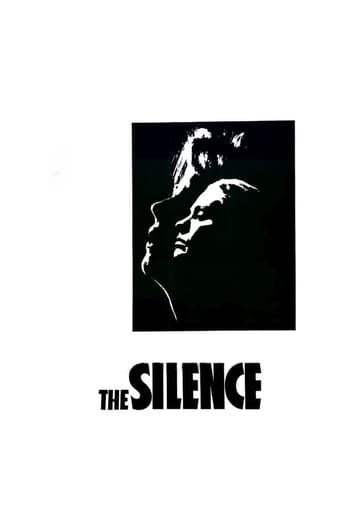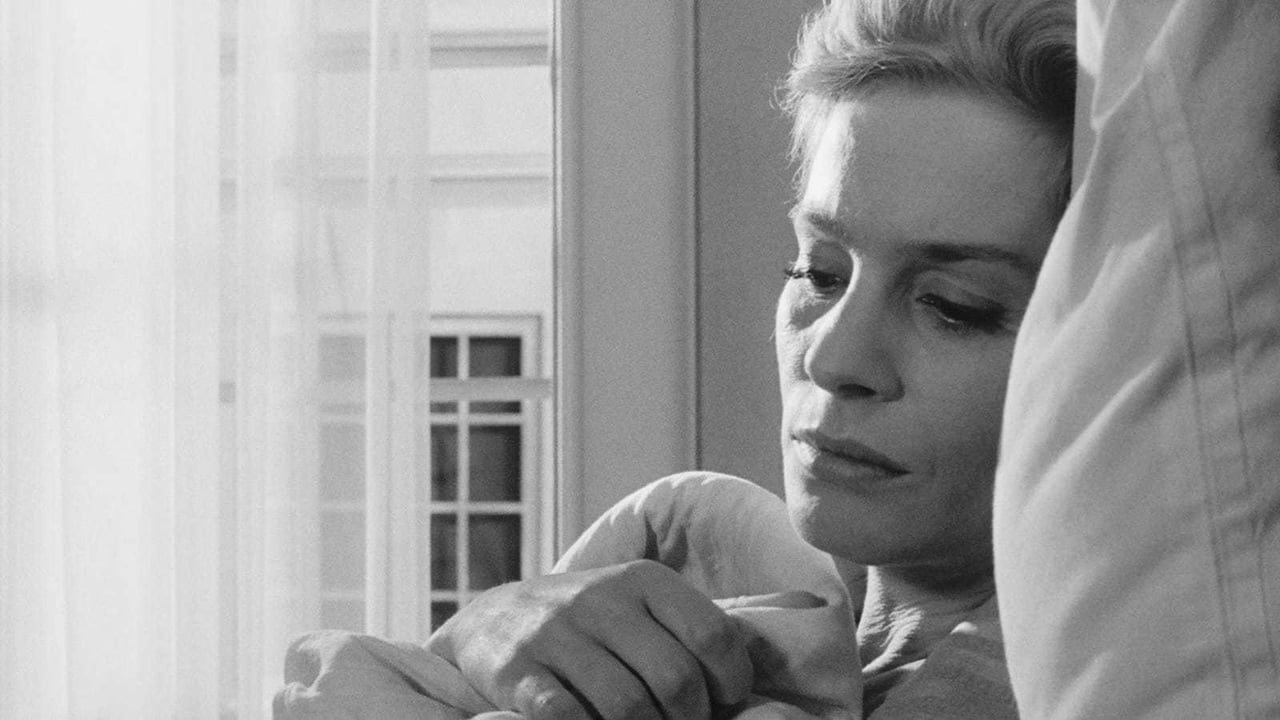Smoreni Zmaj
Camera and directing make this film visually perfect. Every frame is black and white art photography, many of which leave you breathless. There's hardly a dialogue in the movie and sound is so naturally blended with picture that at times it seems like a silent movie. There are not many developments and for a while it was quite boring to me, but when it ended I instantly wished to see it again. Bergman doesn't need action and dialogues to tell a story. Camera and body language are more than enough. Ingrid Thulin and Gunnell Lindblom will impress you with their acting, and also with beauty. This movie opens many questions and doesn't provide answers, but rather leaves that task to our subjective interpretations. I was going through some reviews and came across a variety of interpretations, but I think that attempts to explain this film are essentially a waste of time. It's quite enough just to experience it in and for yourself.8/10
Chrysanthepop
Bergman's 'Tystnaden' is not a comfortable film to watch because of its underlying dark and disturbing theme. He explores the devastating consequence of an incestuous relationship between two sisters, Ester and Anna. The destruction seems to have taken a toll on Esther's health while Anna seems to be mentally and emotionally shattered (unable to connect to others and engaging in casual sex). Amidst this is Anna's son Johan, who, like any curious child, is exploring his own world.Bergman's film starts off with the three principle characters in the train and then ends with Anna and Johan in a train as they have left Ester behind. Perhaps this last scene symbolizes Anna's escape from her traumatic experience. Bergman uses a lot of symbolism but he doesn't spoonfeed them to the viewer. It is all there in his subtle presentation. He also stresses on contrasts between different ideas such as Johan's youthful innocence (his way of seeing the world) vs the confused world interpreted by his mother and aunt. His display of the relationship between the two sisters is brilliant. A strong maternal bond is displayed in the relationship between the mother and child. It may seem as though her son is the only one with whom Anna has a stable relationship but at the same time she goes wandering off in the city leaving her child behind in the hotel. Even as a mother she is broken by the trauma. The movie has many silent moments (quite obviously given the title) but the contrast between these moments are noticeable because it is quite unsettling as the rawness of the tension is exposed. Ingrid Thulin, Gunnel Lindblom and Jörgen Lindström are stupendous in their roles as they portray the complexity of the relationships through subtlety. The cinematography is outstanding. The closeups are particularly haunting. I was surprised by the amount of nudity and sexuality (I have nothing against it) but then again, this is no conventional 60's film. It is a brave and poignant film that was ahead of its time.
ferdinand1932
It takes time for this to become a drama and when it does its resentment again. Bergman uses confessional hate between people often eg. Winter Light, Autumn Sonata and here as the spur to conflict. It works dramatically, its horrible and its also cathartic.But the weakness in this film is that its suggested and not fully rendered and consequently The Silence lacks the qualities of the first two in the so-called trilogy. They have a richer meaning in the dialog, in the circumstances, where this sometimes feels like an exercise in making cinema.Observing people wandering about is interesting for only a limited amount of time, another level of insight must be given. It also shares qualities with the third part of Antonioni's trilogy -- L'Eclisse, which is about people incapable of communicating, leaving silence. L'Eclisse is a much stronger film.Even so, the lead actors are bewitching, as are the photography and compositions too.
Jugu Abraham
There are different strokes to appreciate The Silence.The first is the theological/existential perspective. Contrary to many published reviews on the trilogy, I find the three films affirm the existence of God in the face of doubt. What is the silence referring to? God appears to be quiet; yet the ailing Ester communicates with her nephew by providing him a piece of paper with a foreign word "hadjek" that means "soul" or "spirit". Is that a word that a woman disillusioned with existence of God would pass on to her nephew on her deathbed? I have doubts about Bergman's professed agnosticism. "Hadjek" is the last word of The Silence spoken by Johan reading from the list of foreign words from Ester's letter to him that he jealously guards from his own mother Anna. Somewhat like "rosebud" in Citizen Kane. Again there are two shots towards the end of The Silence that offer Christian symbolism affirming faith in God. First, there is the last shot of Ester her face directed at light from the window, fully exposed to light, as she waits for her eventual death, content at having passed on the letter to her nephew. The second is the last shot of Anna her bathing her face in rainwater (a symbol of baptism) having read the contents of the letter that Johan holds in his hands. Now Bergman gave names to his film's characters with considerable thought, incorporating Biblical connections that he probably picked up from his father's sermons. The priest Tomas in Winter Light is so named because St Thomas doubted the resurrection of Christ, just as Tomas is questioning the existence of God. Ester in The Silence is obviously named after the Biblical book Esther, one of the only two books in the Bible that does not mention God directly. Does the absence of God mean the book is not holy? By corollary, does the silence of God mean that God does not exist? For the atheist viewer of The Silence, too, there is sufficient room to record the director's observation of deserted churcheswhen Anna truthfully confesses to her elder sister that she had sex with a waiter in an empty church. For the existentialist viewer, there is silence from God to the cries of help from Ester. Yet another way to appreciate The Silence is to study the physical silence in the film. Spoken words are indeed few. The film begins with the tick-tock of a watch/clock, which stops when the characters break their silence. The watch is also a metaphor for the limited time of life on earth available for each individual. The sound of the tick-tock increases when Ester is unable to breath and is mortally afraid of dying from suffocation. It is also heard when Anna is reflecting on her post-coital satisfaction in her hotel room. Words are fewthe foreign words learnt in the unnamed country relate to "hand", "face" and finally "soul". Much of the visual communication relates to "hands" and "faces", particularly those of Ester. Ester's hands move even when she is sleeping. Ester's hand caresses Anna's hair but stops short of touching the face. The denizens of the unnamed country hardly speak, yet we know all is not well, with tanks moving in the night and underfed horses pulling carts of furniture to nowhere. Death seems around the corner. One of the few other sounds we hear is the click of the toy gun, disturbing the cleaner of the chandelier. Then there is the clank of the tank negotiating the narrow street outside the hotel. More importantly, silence in the film between individual characters in the film, existing side by side with the theological silence.A third way to evaluate complex issues of The Silence is to study the camera-work of Sven Nykvist. Much of the brilliance of the black-and-white film revolves around shadows and light, mirrors and last but not the least, close-ups. The carnal events are captured in shadows, while epiphanies are swathed in bright light. Nykvist and Bergman use mirrors to indicate the lack of direct communication or rather the presence of bounced communication. When Ester, the translator of languages cannot converse with the maitre d'hotel, she resorts to sign languageeven the boy Johan prefers Punch and Judy to communicate his feelings rather than read a book for his sick aunt. The extraordinary performance of one of cinema's finest actresses, Ingrid Thulin, would have been difficult to perceive were it not for Nykvist's close-ups of her face and hands.A fourth way to approach The Silence is the character of the young boy Johan, who probably is the personification of the young Bergman. Johan is a mix of irreverence (he urinates in the hotel corridor) and innocence (he willingly cross-dresses at the behest of the dwarfs). He is attached to his mother, but respects his aunt even more. As the film un-spools, it is evident that he obeys his mother but is able to connect with the aunt's higher level of intellect, quite aware that she is dying. Johan's father exists but is not physically present. Johan is figuratively squeezed between his mother lacking a "conscience" and an aunt with a domineering and an implied lesbian relationship with his own mother. It is not a perfect life for a boy. Indirectly, Bergman wants the viewer to step into Johan's shoes, irreverent yet innocent and loving. Johan is first introduced to death by the personal collection of family photographs of the maitre d'hotel, including photographs of his dead wife. But John prefers to hide them beneath the carpet but resurrects the subject in his own Punch and Judy show for his aunt.Then you can look at The Silence as the quintessential Ingrid Thulin film. In The Silence her facial expressions are the very imprints one associates with Peter O'Toole's thespian turns in cinema. It is no wonder that she acted in films of topnotch directors: Bergman, Visconti, Resnais and Minnelli.


 AD
AD




